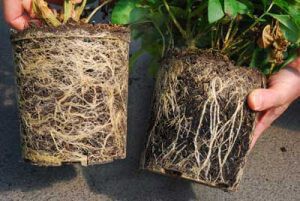
Spring fever will strike at any moment. Are you ready for it? You can be if you follow a few simple guidelines as you head out to the nursery for that next big purchase. Bringing home healthy, disease free plants will make your garden look better and make your gardening experience more enjoyable.
Most plant buyers cannot overcome the urge to purchase plants that are in full bloom in the nursery. Who can resist the temptation to bring home the most beautiful plants? You and me, I hope. Plants already in bloom require a lot of energy to sustain those blooms.
Next time, choose plants that have flower buds but are not yet in bloom. This way you can get the plants in the ground and allow time for the roots to establish a bit first. Even better, pinch off the flower blooms completely when you plant. They’ll come back and the roots will receive the plant’s energy resulting in more established plants that look even better.
First, check the roots. If it is a woody ornamental, tree or shrub, don’t be afraid to pull it from its container. Healthy plants will have roots that are light in color. They will appear evenly distributed without looking crammed. Stay clear of plants that have dark roots or ones that have roots that spiral around the inside of the container. These plants are pot bound and may have a difficult time establishing in the landscape.
Inspect each plant for signs of pests as many hide on the underside of the leaves. Look closely as you might miss them at first glance. You might have a clue of their presence if you see leaf stippling, small black flecks or a sticky residue, especially on the underside.
Avoid purchasing plants that appear to be leggy or stretched. These plants have been growing in light that was insufficient for their needs. Although they may recover, they have been stressed. Your goal for a great looking plant long term is to purchase plants that have not been under any apparent stress.
Foliage that is abnormally light may be a good indication that the plant was over or under watered. These extremes exhibit similar symptoms. Either case is undesirable and adds additional stress to the plant.
Another good way to reduce plant damage caused by diseases is to purchase plant varieties that are disease resistant. This does not ensure that plants will be immune from any particular disease, but it does indicate that the plant displays characteristics, which minimize the impact of a certain disease. These plants have a genetic ability to resist significant damage to a certain disease or pathogen.
Be sure to recognize that “resistant” doesn’t mean immune. What qualifies the plant to be considered resistant is the relatively small degree of impact that a certain pathogen has on that particular plant variety.
The best way to know if you are buying a disease resistant variety is to do your homework. The internet, books, newsletters, magazines and your county extension service are all good sources. Your local county extension service is also a great source for information and is specific to your area and zone. The best way to keep unhealthy plants out of your garden is to leave your emotions at home next time you head for the garden center. Apply tough love when shopping for plants. In the long run, you’ll be glad you did.